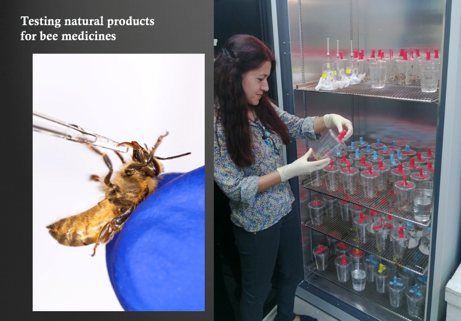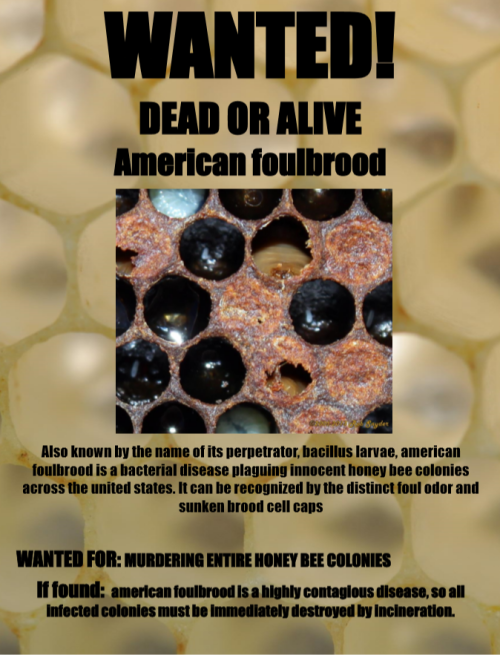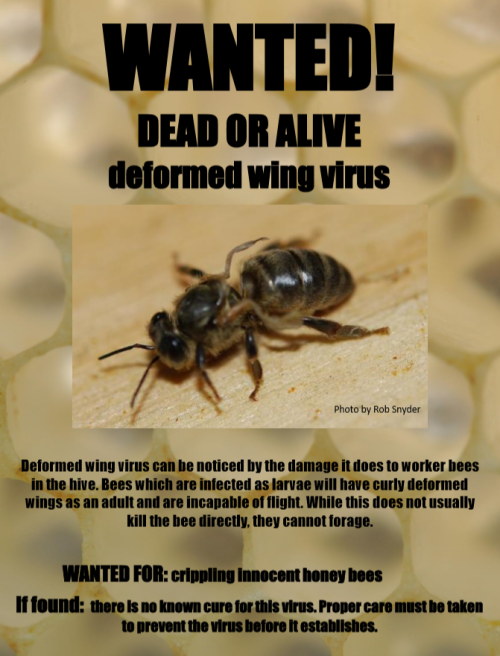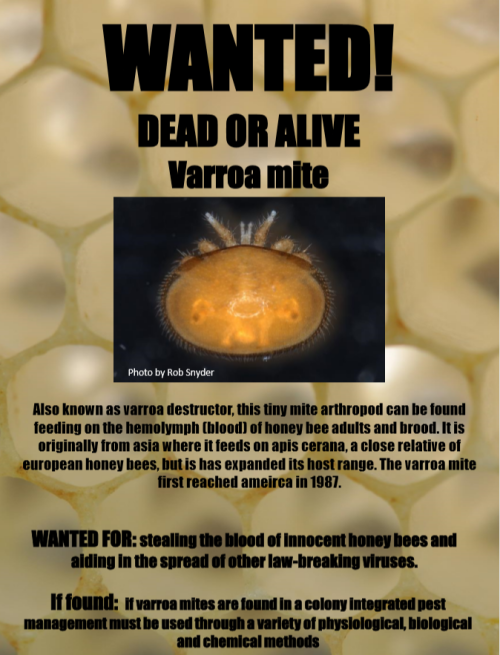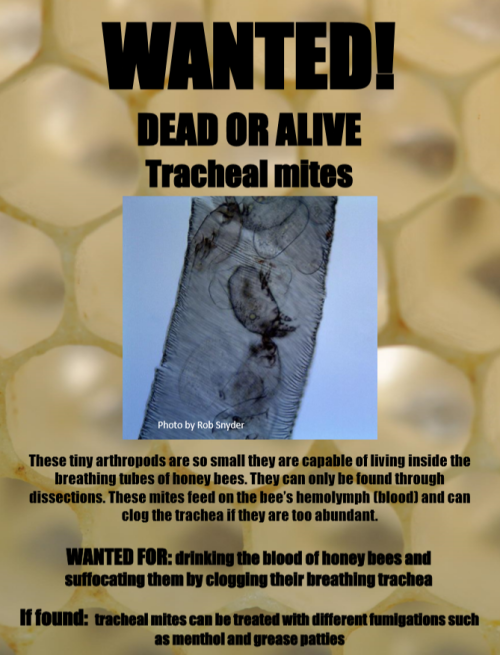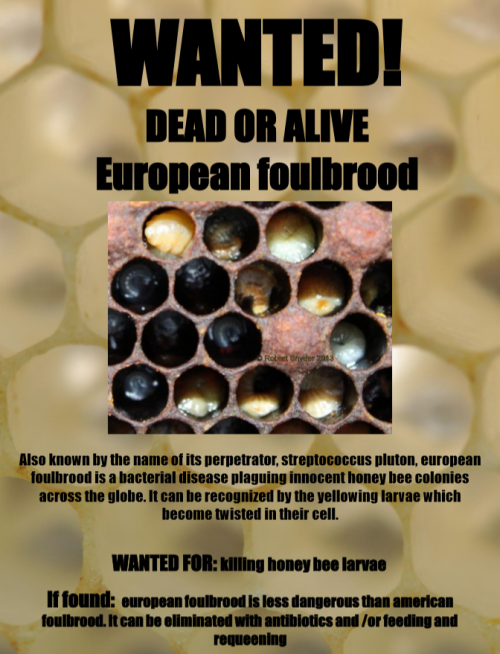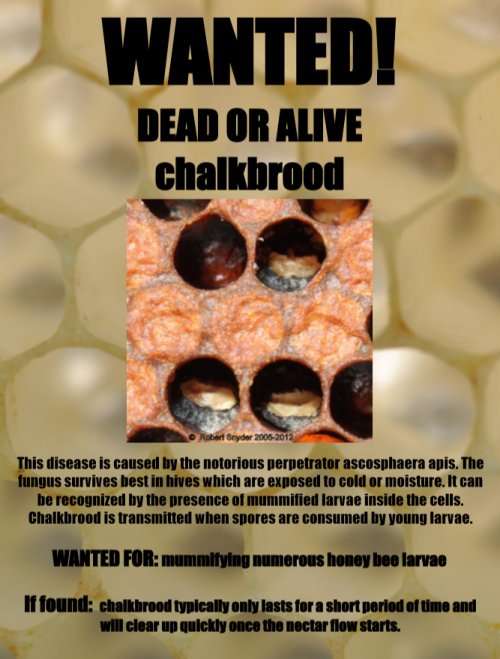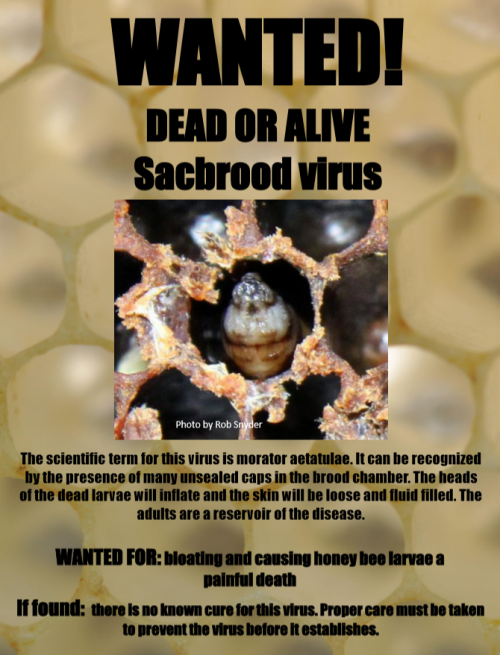Honey Bee Health Task Force
Determine priority criteria for annual Bee Health Grants and develop a sponsorship plan to increase support and partnerships for bee health research. Disseminate information about access to this online tool in the beekeeping community.
Wanted Posters: Honey Bee Pests and Diseases
NAPPC Past Honey Bee Health Grantee Updates
James Nieh, University of California San Diego
The understudied honey bee: exploring the role of feral honey bees in pathogen dynamics in pollinator communities of Southern California (2020)
Although the ways in which viral diseases manifest in managed bee populations are reasonably understood, the prevalence and effects on viruses on feral honey bees remain a relative black box. Managed bees harbor many diseases—many of which also infect feral bees and native bees8. Whether spillover and spillback between managed, feral, and native bees occurs is a question of current interest8. Our study seeks to address this issue in two ways: 1) Many studies conduct surveys over a limited time scale, although honey bee pathogens fluctuate considerably between seasons15,16. Our study will incorporate this seasonal variation by sampling at multiple times over the year to better capture pathogen fluctuations, not only in managed bees, but also in feral honey bee colonies and native bee populations. 2) We will test the hypothesis that FHB are more resilient to many viral pathogens, and likely play a prominent role in their communities as pathogen sinks.
This will help to elucidate the interactions between native bees, managed and feral honey bees throughout the year. Better understanding pathogen sources and the seasons in which they are most prevalent may allow us to design mitigation strategies to improve managed honey bee health and, potentially, to help protect native bee species.
Testing the effects of nicotine, a natural plant metabolite found in nectar, on honey bee nosemosis (2016).
Hendriksma, H. P., Bain, J.A., Nguyen, N., and Nieh JC. (2019) Nicotine does not reduce Nosema ceranae infection in honey bees. Insectes Sociaux. https://doi.org/10.1007/s00040-020-00758-5.
Bee-collected pollen and nectar contain multiple phytochemicals that can have anti-pathogenic effects when ingested. We tested the hypothesis that nicotine can reduce infections of a common microsporidian pathogen, Nosema ceranae, in the honey bee gut. We found however that that a field realistic exposure dose of 1 ppm nicotine was not preferentially consumed by Apis mellifera foragers fed live Nosema spores (5⨯104 spores per bee; N = 160). One-day-old bees infected with Nosema (1⨯104 spores per bee; N = 160) showed no repression of nosemosis over a chronically applied exposure gradient. Since imbibed nicotine may not effectively reach the spores in the bee gut, we conducted an in vitro experiment, in which Nosema spores were exposed up to 104 ppm nicotine in vials, rinsed of nicotine, and then fed to one day old bees (2⨯104 spores per bee; N = 216). However, the in vitro nicotine-treated spores remained infectious. Nicotine did impair effects bee mortality at high concentrations. Dietary nicotine is evidently not a treatment for nosemosis, but future studies should continue to examine the role of phytochemicals and bee health.
The long term benefit is that we can now focus on other natural compounds that may enhance bee health.
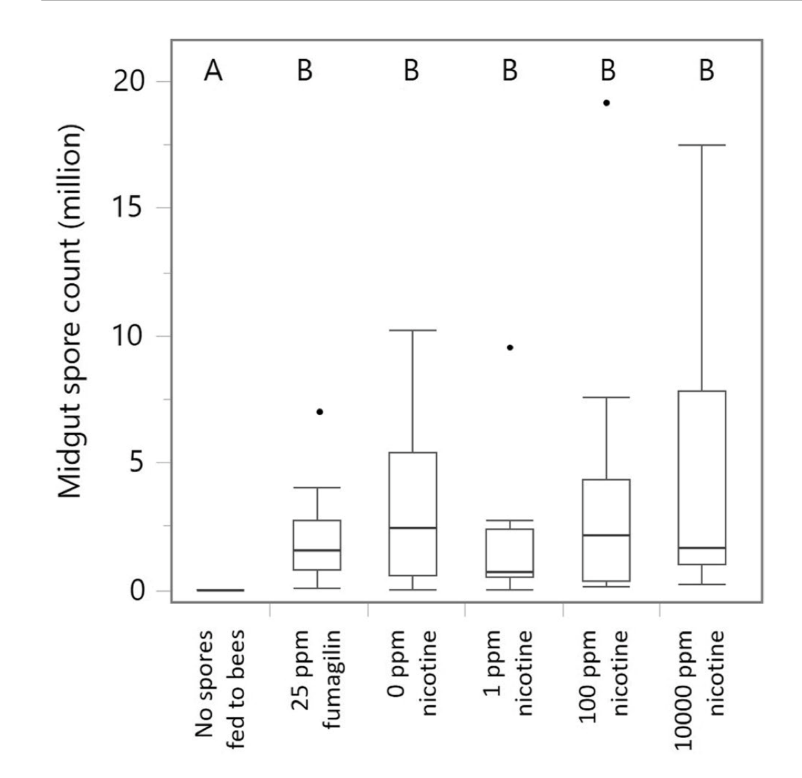
Activating honey bee immunity against Nosema disease: a pilot experiment (2013).
Apis mellifera, the Western honey bee, is an essential pollinator in a multitude of worldwide ecosystems, and therefore occupies a prominent niche in the agricultural industry. Microsporidia like Nosema ceranae are a serious threat to colony health; we demonstrated that immune priming (IP) of newly emerged A. mellifera workers using autoclaved N. ceranae spores can activate an immune response, resulting in lower infection levels after subsequent challenge with live N. ceranae spores. Upon death, bees that were immune primed and challenged were observed to have significantly lower (34%) infection levels than bees given solely pathogenic spores. Immune primed bees also demonstrated a decreased rate of infection. However, the benefit of IP was partially offset by tradeoff in longevity. IP bees survived slightly (1 d) but significantly less than control bees that were not primed or challenged. To determine the mechanisms involved, we analyzed immune gene expression levels of four Toll genes involved in fighting N. ceranae infection. We did not obtain clear results due to high variation in gene expression. However, IP significantly increased expression of apidaecin, hymenoptaecin, and defensin, and this may account for a decreased level and rate of infection in IP bees that were subsequently challenged with live spores. We are currently completing this manuscript as part of a larger collaboration involving several new experiments, including full colony tests, with Zachary Huang.
The long term benefit is in enhancing our understanding of honey bee immune priming and potentially developing a way to use immune priming with bees.
Students working on this research, including Matt Endler (forefront), who earned his MS in 2014 on this project

CCD and the empty-colony syndrome: effect of the pesticide imidacloprid on honey bee distance estimation (2010)
Eiri D, Nieh JC (2012) A nicotinic acetylcholine receptor agonist affects honey bee sucrose responsiveness and decreases waggle dancing. Journal of Experimental Biology. 215:2022-2029.
Because of some problems with getting bees to behave appropriately in a flight tunnel, we switched to look at a related question, how imidacloprid affects honey bee waggle dancing. This resulted in the manuscript shown above and, as part of a large body of research by multiple labs, helped to influence policy makers in the EU to ban neonicotinoids,
A nicotinic acetylcholine receptor agonist, imidacloprid, impairs memory formation in honey bees and has general effects on foraging. However, little is known about how this agonist affects two specific aspects of foraging: sucrose responsiveness (SR) and waggle dancing (which recruits nestmates). Using lab and field experiments, we tested the effect of sublethal doses of imidacloprid on (1) bee SR with the proboscis extension response assay, and (2) free-flying foragers visiting and dancing for a sucrose feeder. Bees that ingested imidacloprid (0.21 or 2.16 ng bee–1) had higher sucrose response thresholds 1 h after treatment. Foragers that ingested imidacloprid also produced significantly fewer waggle dance circuits (10.5- and 4.5-fold fewer for 50% and 30% sucrose solutions, respectively) 24 h after treatment as compared with controls. However, there was no significant effect of imidacloprid on the sucrose concentrations that foragers collected at a feeder 24 h after treatment. Thus, imidacloprid temporarily increased the minimum sucrose concentration that foragers would accept (short time scale, 1 h after treatment) and reduced waggle dancing (longer time scale, 24 h after treatment). The effect of time suggests different neurological effects of imidacloprid resulting from the parent compound and its metabolites. Waggle dancing can significantly increase colony food intake, and thus a sublethal dose (0.21 ng bee–1, 24 p.p.b.) of this commonly used pesticide may impair colony fitness. The long term benefit has been to help contribute to the restriction of neonicotinoids in crops in which they could affect bees.
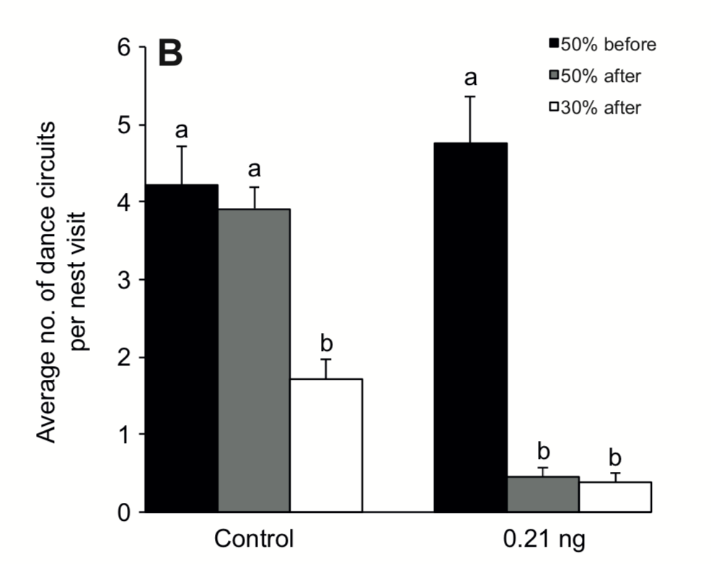
Makaylee Crone, Penn State University
Manipulating pollen macronutrient ratios to improve honey bee resilience to pesticide stress (2019)
We modified diets for honey bees by adding or extracting proteins and lipids from pollen. Diets were fed to bees while they were chronically exposed to a pesticide stressor. We found that the pollen diet that led to the highest level of survival was often at a protein to lipid ratio of 3.6:1 or 4.5:1, but in some trials protein rich diets performed just as well. This may indicate that the ideal diet for bees can change based on many factors, likely including previous nutrition, genetics, and pathogen load. We plan to continue this research by examining survival of bees that consume diets with naturally different protein to lipid ratios, with and without a pesticide stressor, to see if these trends remain the same. This seed grant supported my first year of PhD research and allowed me to practice grant writing, fund management, and undergraduate management, which is invaluable experience that will help me in my academic career. The data gained from this project will also lead to a better understanding of honey bee nutrition, which will help us develop better synthetic diets and pollinator planting schemes. Additionally, our recently published work that cataloged pollen protein to lipid ratios broadly for plant species can be coupled with data from this project to develop improved pollinator planting schemes.
Ana Montero-Cataño, University of Guelph
Elucidating the role of crop flowers as reservoirs of pathogens and the influence of the pollinator community on pathogen transmission to honey bees (2019)
So far, our preliminary results show that flowers can be reservoirs of bee pathogens. From the seven pathogens screened in blueberry flowers, we found three with different frequencies: Nosema ceranae, Deformed Wing Virus (DWV) and Black Queen Cell Virus. Whether farmers placed honeybee hives or not, the presence of DWV in crop flowers was not affected, but it was negatively related to the cover of natural habitats in the landscape. Foraging behavior, and specially robbery rates, seem to play and important role in DWV transmission via flowers. In fields with higher robbery rates, the presence in flowers (see Figure below) and the prevalence in honeybees of DWV was lower.
Long-term benefits of this seed-grant:
- Ongoing scientific collaborations with the other two labs involved in this project: Dr. Dirk Steinke Lab (University of Guelph) and Dr. Mariano Higes (Centro Apícola de Marchamalo). In addition, all samples are properly preserved for answering future questions.
- Collaboration established after joining the Bombus Task Force during the 2019 NAPPC Annual Meeting with other six early career researchers to explore best practices in bee collection methods.
- From the management point of view, this study adds evidence on the importance of large scale approaches towards long-term healthy and productive agro-ecosystems.
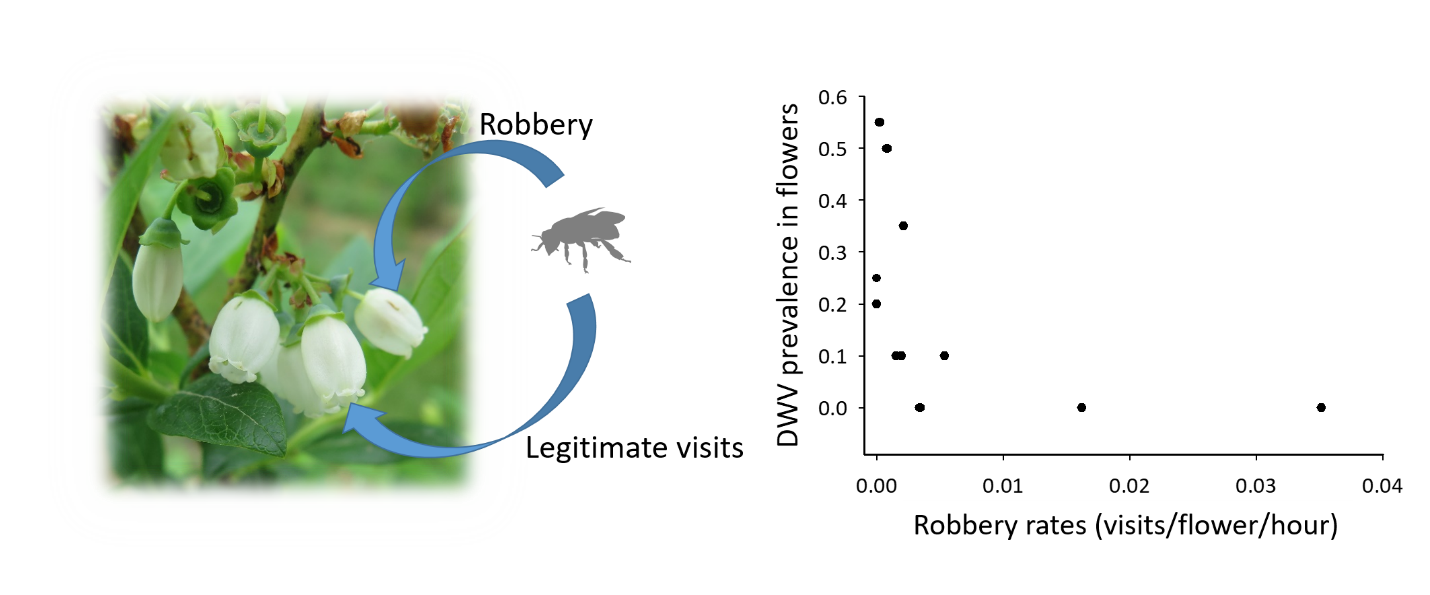
Sabrina Rondeau, Universidad Laval
The predatory mite Stratiolaelaps scimitus as a biological control agent against Varroa destructor (2017)
Short paragraph of the principal finding from that project
This project was conducted at the Université Laval, Quebec, Canada. The main objective of our study was to assess the potential of the predatory mite Stratiolaelaps scimitus to control Varroa destructor. More specifically, we aimed to evaluate the effectiveness of the predator in controlling varroa densities in honey bee colonies during a fall treatment in comparison with thymol, a widely used organic acaricide of known effectiveness. Mite drops from colonies were monitored with sticky boards once a week from two weeks before to one week after treatments. A follow-up treatment was then performed using Apivar®, which allowed us to estimate the effectiveness of each treatment (control, two doses of S. scimitus: 6,250 or 12,500 mites/colony, and Thymovar®). Our results showed that S. scimitus failed in controlling varroa populations in honey bee colonies when introduced in early fall according to current suppliers’ recommended rates and application method. On the other hand, our results demonstrated that Thymovar® remains an effective option for controlling varroa mite populations during fall in Quebec, Canada. Among the other findings resulting from this project, our laboratory trials also showed that S. scimitus does not attack varroa mites when they are attached to the body of adult bees. We believe this inability to predate on phoretic mites to be the main reason explaining the ineffectiveness of S. scimitus to control varroa mites.
Brief statement on any potential long-term benefit of this seed-grant
Receiving the 2017 NAPPC Honey Bee Health grant helped us to further secure an additional grant of $3,000 USD from The Eastern Apiculture Society Foundation for Honey Bee Research to add an additional component to our project. Along with graduate scholarships and the significant in-kind support of the Centre de recherche en sciences animales de Deschambault (CRSAD), these two grants funded most of Sabrina Rondeau Master’s project. The research funded through the NAPPC grant also allowed us to acquire fundamental scientific knowledge about the behaviour of an important generalist biological control agent and led to many scientific communications, many extension publications (including: https://theconversation.com/mite-versus-mite-the-search-for-an-effective-way-to-save-honeybees-108873), and two research papers:
- Rondeau S, Giovenazzo P, Fournier F. 2019. The Use of the Predatory Mite Stratiolaelaps scimitus (Mesostigmata: Laelapidae) to Control Varroa destructor (Mesostigmata: Varroidae) in Honey Bee Colonies in Early and Late Fall. Journal of Economic Entomology. 112(2): 534-542
- Rondeau S, Giovenazzo P, Fournier F. 2018. Risk assessment and predation potential of the predatory mite Stratiolaelaps scimitus (Acari: Laelapidae) to control Varroa destructor in honey bees. Plos One. 13(12): e0208812.
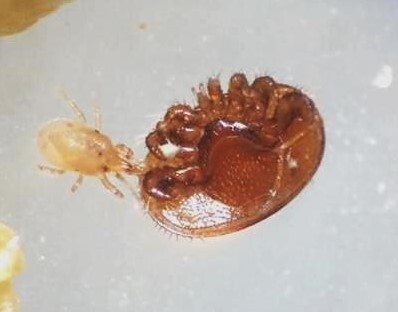
Jonathan Snow, Barnard College, Columbia University
Development of novel Nosema infection assays for diagnostics (2016)
Nosema ceranae and Nosema apis, are microsporidian parasites that are highly pathogenic to honey bees and have been implicated as a factor in honey bee losses. While traditional methods for quantifying Nosema infection have high sensitivity and specificity, there is no field-portable device for field measurements by beekeepers. In our project, inititated with funds from NAPPC, we designed and tested a field-portable and cost-effective smartphone-based platform for detection and quantification of chitin-positive Nosema spores in honey bees. The handheld platform, weighing only 374 g, consists of a smartphone-based fluorescence microscope, a custom-developed smartphone application, and an easy to perform sample preparation protocol. We tested the performance of the platform using samples at different parasite concentrations and compared the method with manual microscopic counts and qPCR quantification. We demonstrated that this device provides results that are comparable with other methods, having a limit of detection of 0.5x106 spores per bee. Thus, the assay can easily identify infected colonies and provide accurate quantification of infection levels requiring treatment of infection,
While more work is needed, our results suggest that this method is potentially adaptable for diagnosis of Nosema infection in the field by beekeepers. Coupled with treatment recommendations, this protocol and smartphone-based optical platform could improve the diagnosis and treatment of nosemosis in bees and provide a powerful proof-of-principle for the use of such mobile diagnostics as useful analytical tools for beekeepers in resource-limited settings.

David Tarpy, North Carolina State University
Investigating a new way to combat viruses with RNA-targeting biotechnology in Apis mellifera (2016)
Project summary: Genome editing is developing at a fast pace in recent years since the discovery of CRISPR/Cas9 nuclease technologies. Our hypothesis was to see if the CASPR/FnCas9 system can be harnessed to target the highly conserved sequences identified in dicistroviruses such as IAPV. The goal was to provide a proof of concept and to test the feasibility of CRISPR/FnCas9 in honey bees in vitro and in vivo. We successfully established a semi-automated egg-injection system at our Lake Wheeler Honey Bee Research Center and were able to rear injected- and control-eggs to the larval stage in vitro. However, given the low success rate of injection (1 out of ~1,000) and the high degree of manipulation, we were unable to successfully rear any queens or drones using this technique.
Long-term impacts: The biggest outcomes from this project, while not direct, were the indirect successes. The de facto PI for the project, Dr. Hongmei Li-Byarlay, was able to become proficient with the technique and determined many of the logistical landmines to avoid in future applications. More importantly, she was able to take her expertise to a tenure-track faculty position at Central State University in OH, where she has now started her own program. In addition, she helped to train two undergraduate research assistants during that field season, as well as make an impactful visit to Dr. Martin Beye’s lab in Germany (who have the technique working well). We also have a symposium abstract based on this preliminary work in next year’s conference of the International Congress of Entomology (ICE) in Helsinki.
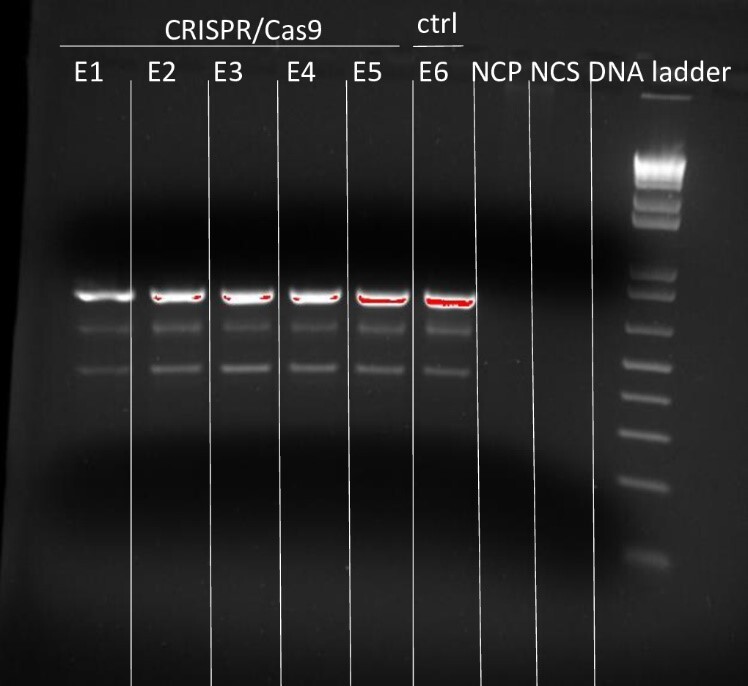
Scott McArt, Cornell University
Assessing the impact of pesticides on honey bee health using a network of controlled, experimental hives (2015)
Attached is the publication that resulted from this seed grant. In terms of long-term benefit, we were just awarded a 3-yr USDA NIFA grant to continue this work, looking more deeply into how fungicide exposure impacts honey bee health via synergisms with insecticides and/or interactions with bee diseases. Also, the data on neonicotinoid exposures from this project are currently being used by the NYS Dept of Ag and Markets and Dept of Environmental Conservation in their deliberations about increased restrictions on that class of insecticides in New York.
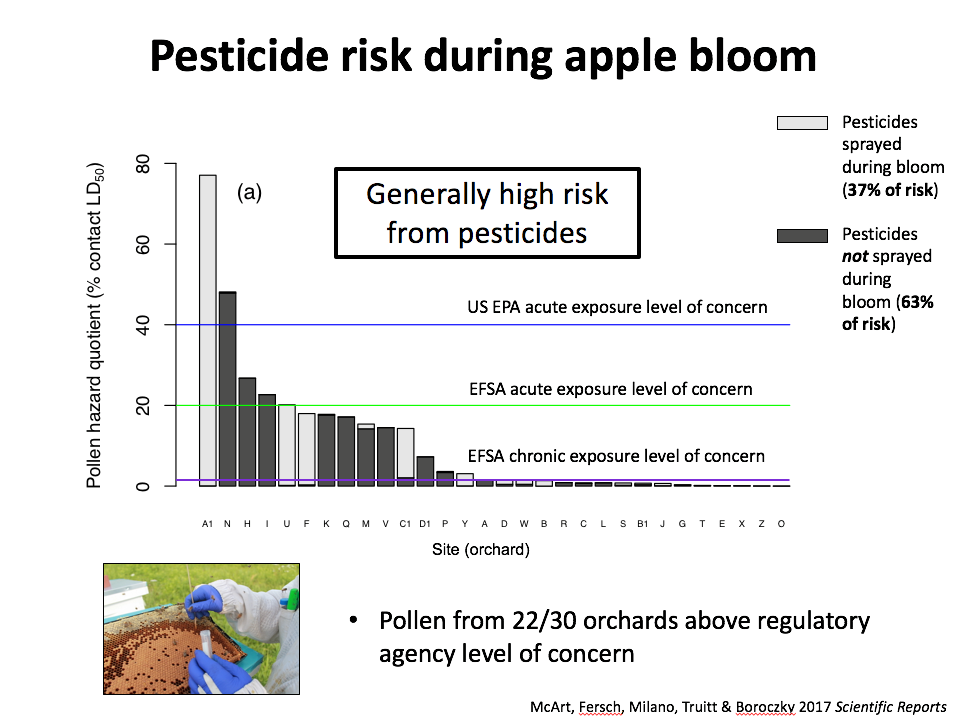
Rodney Richardson, The Ohio State University
Investigating the effects of fumagillin and other common in-hive xenobiotics on immune function in honey bees (2015)
With the help of NAPPC funding, we conducted one of the first broad characterizations of honey bee immune cells, or hemocytes. Hemocytes were collected from larval and adult workers at multiple stages of development to assess the abundance and diversity of immune cells present using cell staining techniques. We also analyzed the capacity of these cells to produce reactive oxygen species in response to immune stimulation. Our results clarify questions about the inner workings of the cellular immune system of honey bees and were summarized in an Apidologie article (DOI: 10.1007/s13592-018-0566-2).
In the long term, our work provides a foundation for future research on the collection, handling and interrogation of honey bee immune cells. Such work is needed improve our understanding of the basic biology of honey bees and in order to develop better methods for investigating immune-related issues, such as disease pathogenesis and immunotoxicology.
Figure: Photos of stained larval granulocytes undergoing the various stages of mitotic cell division. Scale bar represents 10 μm.
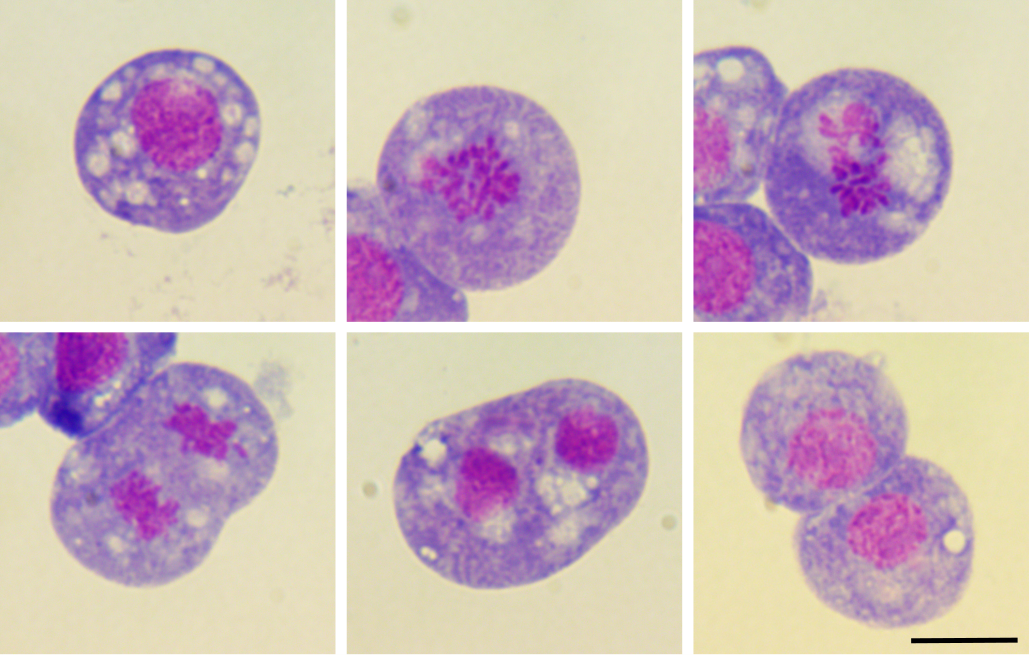
Adam Dolezal, Iowa State University
Do viruses manipulate honey bee behavior in ways that increase their transmission? (2015)
With the funding from NAPPC, we were able to being investigations into how Israeli acute paralysis virus (IAPV) affects honey bee behavior. We found that, inside a colony, bees are able to respond to infection (or non-infectious immunostimulation) with behavioral changes thought to reduce disease transmission. This suggests that honey bees have a generalized response when some individuals have their immune systems triggered to engage a ‘social immune’ response. However, when we studied behavioral responses between colonies, we found that infected bees (but not immunostimulated bees) receive less aggression from guard bees and are, in fact, twice as likely to be accepted into foreign colony. Infection and immunostimulation are also both associated with changes to bees’ cuticular hydrocarbon profiles, the chemical signatures used by nestmates and guards to evaluate the bees they interact with, suggesting a possible mechanism by which IAPV could manipulate this system. We hypothesize that the high colony densities found in modern beekeeping create an environment where such pathogen manipulation would be especially successful. This work was published in 2020: https://doi.org/10.1073/pnas.2002268117. It was also highlighted in an article in Science: https://www.sciencemag.org/news/2020/04/deadly-virus-turns-honey-bees-trojan-horses#
This seed grant was instrumental in beginning the work that is forming a large part of the work performed by the Dolezal lab at the University of Illinois (which did not exist with the grant was funded) in collaboration with the labs of Amy Toth (Iowa State), Gene Robinson (U of Illinois), and Bryony Bonning (U of Florida). The data collected with the original funds were used were instrumental in the funding of a much larger USDA-NIFA proposal. Most importantly, this work shows how a virus could be taking advantage of modern beekeeping practices to increase its own transmission between colonies, potentially even involving movement of Varroa mites. The discoveries from this larger project can be used to better predict disease transmission between colonies and develop strategies to reduce the incidence of interhive disease transmission.
Figure 3C from the published paper, showing that IAPV-inoculated bees are much more likely to be accepted than control or immunostimulated bees.
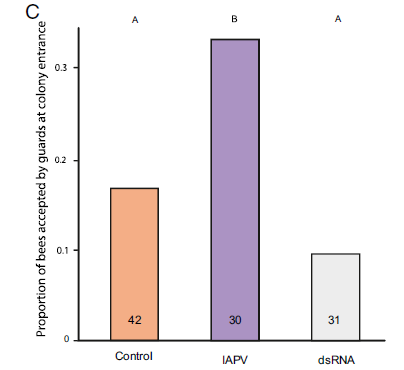
Anthony Vaudo, Penn State University
The effects of pollen diversity on bumble bee health in an agricultural environment. 2014-2015. Anthony Vaudo (PI); Christina Grozinger (Co-PI); John Tooker (Co-PI); Department of Entomology, Center for Pollinator Research, Pennsylvania State University.
This funding supported the graduate research of Anthony Vaudo. It was been used to provide preliminary data for a successfully funded USDA Predoctoral Fellowship for Vaudo as well as elements of three separate research projects and five manuscripts. In our first study, using synthetic diets, we determined how bumble bees regulate their nutrient (carbohydrates, proteins, and lipids) intake to a specific ratio. In the second study, we manipulated single source pollen to different nutritional ratios to determine what are the most attractive nutrient ratios of pollen to bumble bees. The results of these studies indicate that bumble bees are attracted to and regulate their nutrient intake to pollen of high protein:lipid ratios (published in Journal of Experimental Biology and PNAS). In the main project funded by the grant, we wanted to determine if bumble bees are obtaining their preferred nutrients in the landscape and how different habitats affect colony growth. We placed a total of 24 colonies in three different landscapes and 12 different sites and monitored their foraging rates, colony growth, and harvested pollen from returning foragers and analyzed the pollen for its nutritional quality. We found that bumble bees attempted defend their preferred pollen nutrient ratios independent of habitat. Interestingly, the most successful colonies (both number of workers and reproductives produced) had a higher rate of pollen protein and lipid consumption (see figure below; published in Ecology and Evolution). Finally, we published two review papers about bee nutrition and how this information can be applied to habitat restoration for pollinators (published in Current Opinion in Insect Science and Insects). The results of the funded research have been instrumental in advancing the field of pollinator nutrition and conservation. Vaudo is currently a postdoctoral scholar in the Leonard Lab at the University of Nevada Reno working on bee nutritional ecology, studying how pollen nutrition shapes bee-flower community interactions. This research is funded by a NSF grant in which results of the NAPPC funded project were used as support and justification.
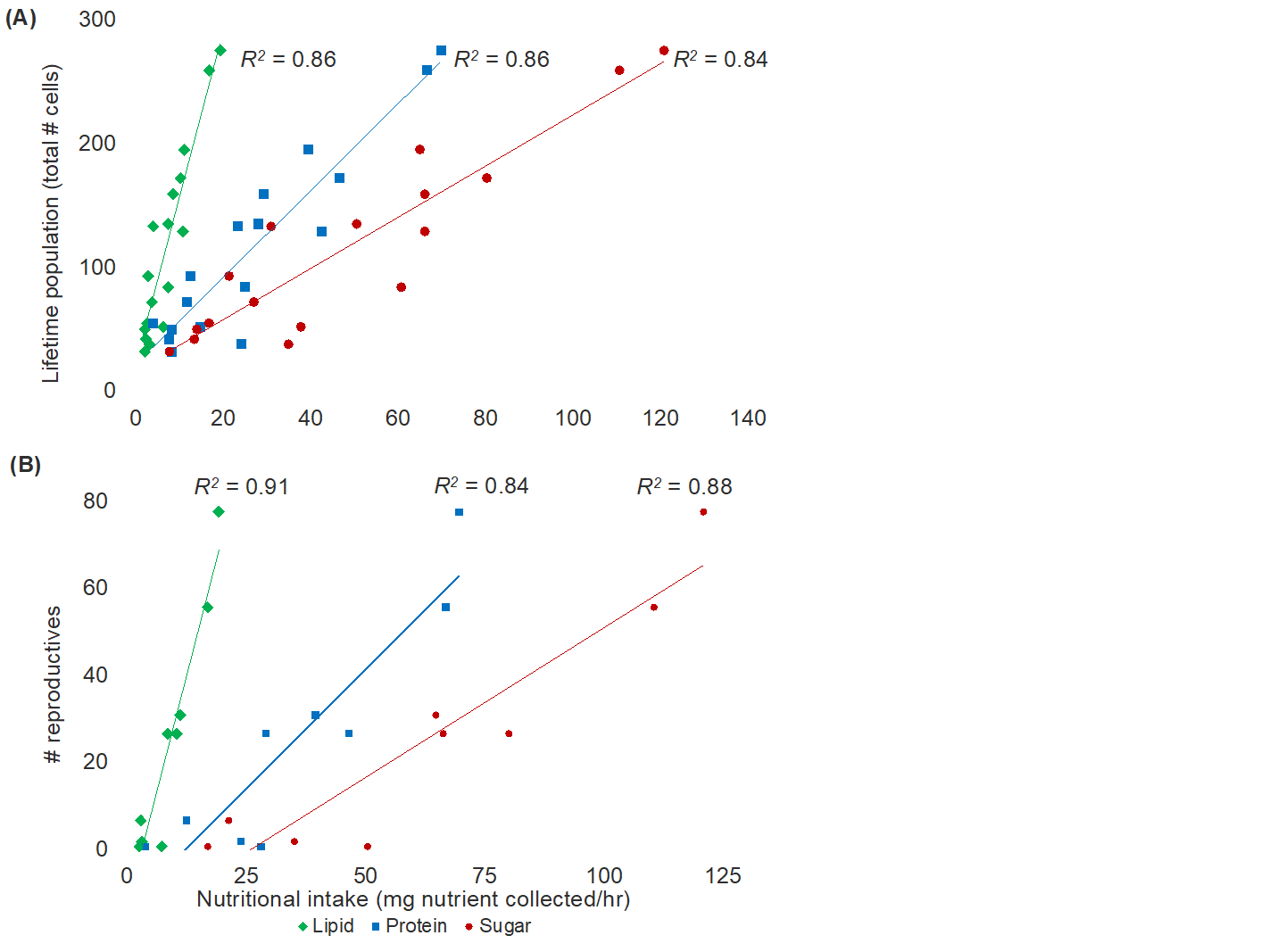
Heather Mattila, Wellesley College
The effect of nutritional stress on the foraging and recruitment activity of honey bee workers (2014)
Here is a shortened version of the abstract from the paper that resulted from my lab's NAPPC grant in 2014:
We examined the effects of larval nutritional stress on the foraging and recruitment behavior of the honey bee. Pollen, which supplies essential nutrients to developing workers, can become limited in colonies because of seasonal dearths, loss of foraging habitat, or intensive management. Because of growing concerns that poor nutrition interacts with other stressors to exacerbate colony decline, we manipulated nurse bees’ access to pollen and then assessed differences in weight, longevity, foraging activity, and waggle-dance behavior of the workers that they reared (who were co-fostered as adults). Pollen stress during larval development had far-reaching physical and behavioral effects on adult workers. Workers reared in pollen-stressed colonies were lighter and shorter lived than nestmates reared with adequate access to pollen. Proportionally fewer stressed workers were observed foraging and those who did forage started foraging sooner, foraged for fewer days, and were more likely to die after only a single day of foraging. Pollen-stressed workers were also less likely to waggle dance than their unstressed counterparts and, if they danced, the information they conveyed about the location of food was less precise. This study highlighted several concerns about the effects of poor nutrition on worker performance and noted that these deficits may escalate if long-term pollen limitation prevents stressed foragers from providing sufficiently for developing workers. Furthermore, the effects of brief pollen shortages reported here mirror the effects of other environmental stressors that limit worker access to nutrients, suggesting the likelihood of their synergistic interaction. Honey bees often experience the level of stress that we created, thus our findings underscore the importance of adequate nutrition for supporting worker performance and their potential contribution to colony productivity and quality pollination services.
Wellesley is an undergraduate women's college and NAPPC funds for this project supported the scientific training of 6 female undergraduate students, two of whom have gone on to pursue PhDs in the sciences, and one in pollinator health specifically. This study also sparked a line of research in my lab that continues today. We've extended our findings from the 2014 NAPPC grant to tasks that honey bee workers perform early in life (i.e., nursing). We've also begun exploring similar questions in bumblebees, another economically important and behaviorally complex social pollinator that faces numerous environmental threats.
Here is a picture of my student Hailey Scofield, working on this project. The NAPPC funds helped to support Hailey's research tech position in my lab the year after she graduated, during which time we completed the study (she'd also worked on it for her senior thesis) and got it published. Hailey went on after that to start a PhD at Cornell with a focus on honey bees.

Izzy Hill, Center for Urban Bee Research
Assessing the role of environmental conditions on efficacy rates of entomopathogenic nematodes for controlling small hive beetles in honey bee hives - a citizen science approach (2014)
Certain species of entomopathogenic nematodes, such as Heterorhabditis indica Poinar, Karunakar & David, have the potential to be effective controls for Aethina tumida (Murray), or small hive beetles, when applied to the soil surrounding honey bee ( Apis mellifera L.) hives. Despite the efficacy of H. indica , beekeepers have struggled to use them successfully as a biocontrol. Although research had been conducted to explore the impact of specific environmental conditions—such as soil moisture or soil temperature—on entomopathogenic nematode infectivity, no study to date had taken a comprehensive approach that considers the impact of multiple environmental conditions simultaneously. In exploring this, a multivariate logistic regression model was used to determine what environmental conditions resulted in reductions of A. tumida populations in honey bee colonies. To obtain the sample sizes necessary to run a multivariate logistic regression, this study utilized citizen scientist beekeepers and their hives from across the mid-Atlantic region of the United States. Results suggest that soil moisture, soil temperatures, sunlight exposure, and groundcover contribute to the efficacy of H. indica in reducing A. tumida populations in A. mellifera colonies.
Additional information about the findings of this study are presented here.
The results of this study offer direction for future research on the environmental preferences of H. indica and were shared at dozens of events to educate beekeepers about methods for better utilizing H. indica as a biological control. Further, the online platform--Bugonia--that was created for this project to collect citizen science information from beekeepers was used several times by other researchers for other citizen science projects, drastically reducing the costs for those researchers' data collection efforts and helping to increase the number of colonies they were able to include in their studies.
A couple of pictures of SHB counts and an example page from the online citizen science platform that was used for data collection. More pictures are available.
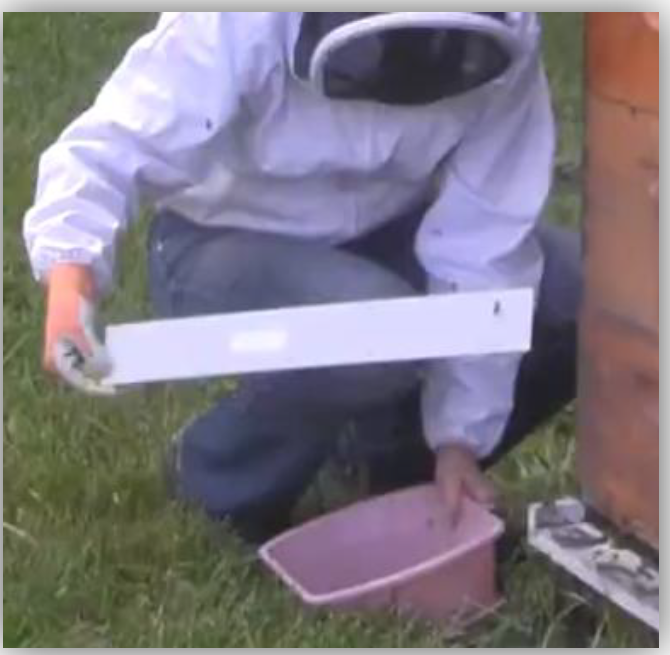
Leonard Foster, University of British Columbia
Comparative analysis of honey bee survival and immune response to co-infections of IAPV and N. ceranae using quantitative mass spectrometry based proteomics (2012)
Our projects original aim was to look at how co-infections of IAPV and N. ceranae affect bee survival and immune responses in the bee. The original project actually led us in two different directions, one leading to a publication in 2015 (doi: 10.1139/cjz-2014-0181) and one leading to a larger grant application that was ultimately successful. The key finding of the published work was the identification of several factors in bee cells that seem to be targeted by the virus, especially the translation (protein production) machinery. The larger grant that we were able to secure was from Genome Canada and has allowed us to develop selective breeding tools for strengthening disease resistance in the bee gene pool
The long-term benefits of this work will be that it was used as seed funding to initiate a much larger project that should ultimately lead to stronger and healthier bees.

Christopher Mayack, Colorado State University
Forager Energetic Stress as a Casual Mechanism for the Depopulation of Honeybee Colonies (2011)
The energetic state of an individual is a fundamental driver of its behavior. However, an individual in a eusocial group such as the honeybees is subject to the influence of both the individual and the colony energetic states. As these two states are normally coupled, it has led to the predominant view that behaviors, such as foraging, are dictated by the colony state acting through social regulatory mechanisms. Uncoupling the energetic state of an individual honeybee from its colony by feeding it with a non-nutritious sugar, we show that energetically stressed bees in a colony with full food stores do not consume this food to meet their energetic shortfall but instead compensate by first reducing their activity level and then by increasing their foraging rate. This suggests that foraging in eusocial groups is still partly under the regulatory control of the energetic state of the individual and supports the notion that regulatory mechanisms in solitary insects have been co-opted to drive altruistic behavior in eusocial insects. The observation that energetically stressed bees also experience higher mortality during foraging also suggests that energetic stress mediated by a variety of factors can be a common mechanism that underlies the recent observation of bees disappearing from their colonies.
This funding has shaped my research direction after completing the described work above and publishing it in the Behavioral Ecology and Sociobiology Journal. In my post doc and currently, I am investigating if highly social bees, like the honey bee, in comparison to more solitary bees and insects, may be particularly susceptible to starving to death while foraging out away from the hive due to physiological constraints on an individual level that has been shaped by strong group selection on the colony level. This research was supported by an Alexander von Humboldt award supporting my post doc in Germany working with Robert Paxton. To date, I have found that honey bee foragers are more reliant upon octopamine in response to starvation causing them to search for food as opposed to mobilizing their fat stores with the use of adipokinetic hormone. The seed funding also ultimately supported my first funded grant as an Assistant Professor from the Turkish Government, I am investigating if fluctuating trehalose levels influence appetite regulation independent of the glucose-insulin signaling pathway and I am aiming to understand the neurological mechanisms that might be involved in this. Therefore, we can better understand how appetite can become uncoupled from the energetic state of the individual, which might explain how energetically stressed foragers dying out away from their hives. Two Masters students and a post doc are supported with this project.
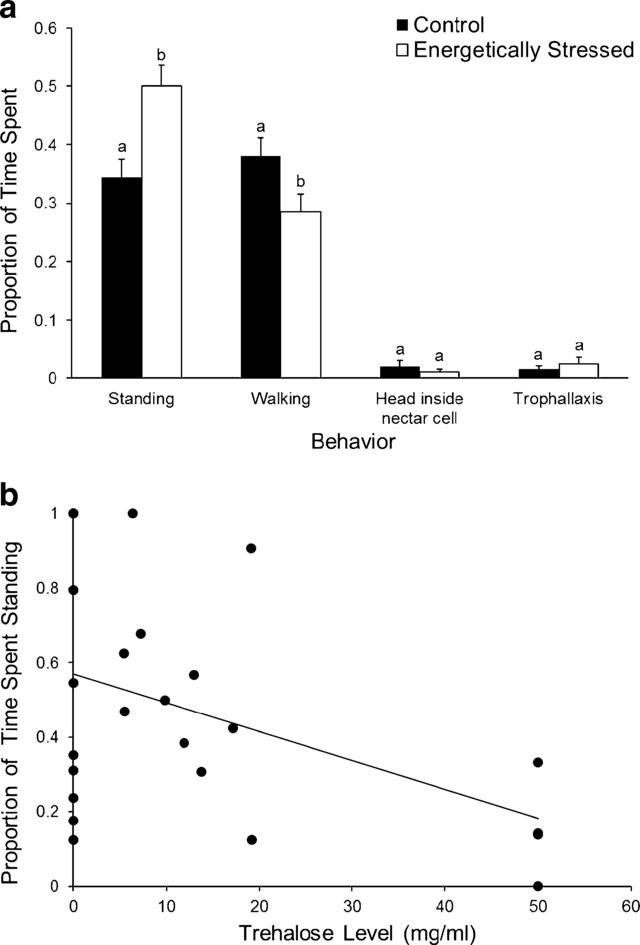
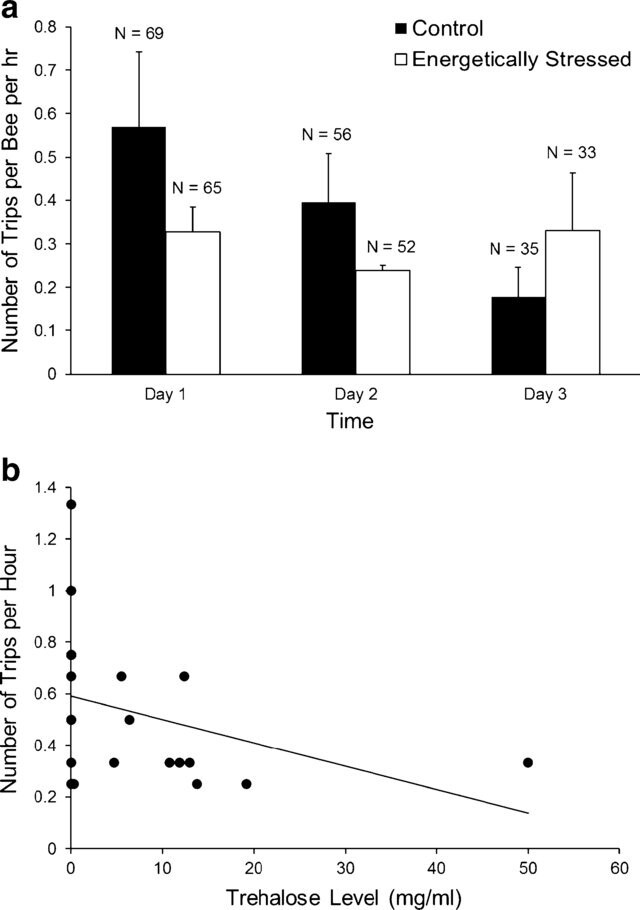
Christian Krupke, Purdue University
Honeybees and field crops: What fills the risk cup for honeybees foraging in areas of corn and soybean production? (2011)
The funding we received from NAPPC was key to helping us perform our initial quantifications of neonicotinoids in a wide variety of matrices, including planter dust, on dandelions, and on dead and dying honey bees, the work is summarized here. The project was originated in response to findings of dead and dying bees at Indiana apiaries in conjunction with nearby planting corn. In brief, we found that during routine planting of neonicotinoid-treated corn seeds, large volumes of dust containing insecticide and fungicide residues are exhausted from corn planters. As a result, honey bees are exposed to lethal and sub-lethal concentrations of neonicotinoid residues both directly (flying through plumes of planter dust exhausted from the planter while foraging), and indirectly (on non-target flowers, including dandelions, growing adjacent to planted fields).
The seed grant initiated a series of projects in my lab group, and also among many collaborators to track and document the routes of exposure for honey bees and many other non-target organisms to neonicotinoid insecticides. The most gratifying part of the work is that it’s been a useful contribution in helping other researchers initiate new and creative ways to tackle this problem – the original work has been cited over 600 times, a testament to the many, diverse research groups that recognize that the most widely-used pesticide class in much of the western world has potential for significant non-target exposures. Neonicotinoid seed treatments were initially thought of as a way to manage insect pests with minimal risks of drift and non-target exposures. We now know that this is clearly not the case, with many off-target exposures documented, including aquatic systems, which are emerging as important sinks for these powerful and widely used insecticides. Perhaps more importantly, there is a growing body of literature that indicates that insecticidal seed treatments are not necessary (in terms of crop protection and yield) on the vast majority of cropland where they are used.
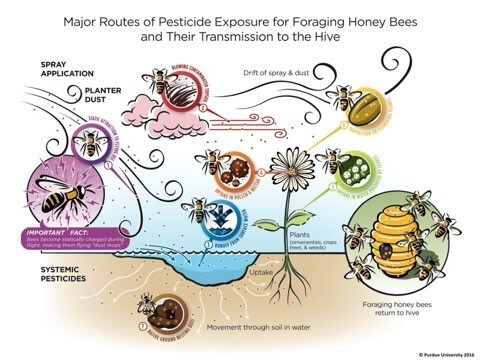
Ramesh Sagili, Associate Professor, Oregon State University
Evaluating effects of pollen quality on honey bee physiology, colony growth and behavior (2010)
Our study evaluated the effects of pollen quality on honey bee physiology, colony growth and behavior. Nucleus colonies were used for this study and were placed in a flight cage to avoid any incoming natural pollen. Experimental colonies receiving pollen with high diversity had significantly higher hypopharyngeal gland protein content and colony growth. Our findings demonstrate that pollen diversity enhances colony fitness by increasing colony growth.
The seed grant from NAPPC helped us secure additional funding to the tune of $400 K from couple of other funding agencies for honey bee nutrition research. Our lab has continued to focus on bee nutrition research and we have published several important publications during the past ten years that have advanced our understanding of bee nutrition which was a relatively understudied area.
Fig 1: Samples of pollen collected from different bee pollinated crops for the study.
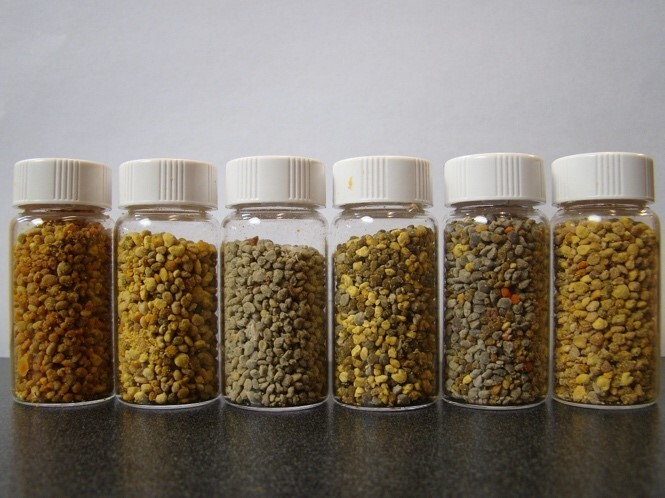
Fig 2. Colony evaluations to estimate colony growth
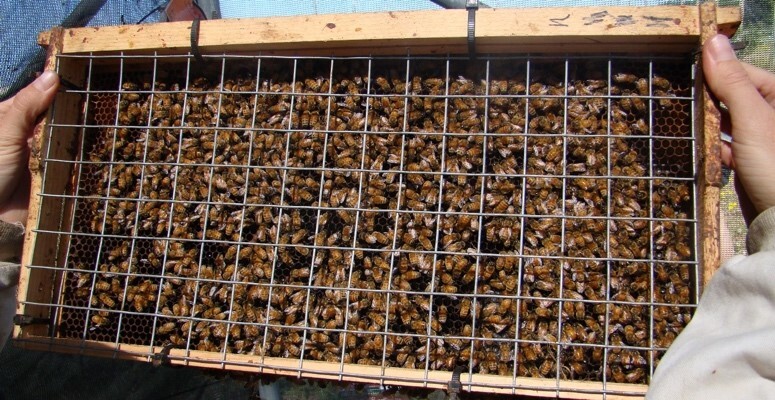
Fig 3. Flight cage with experimental nucleus hives
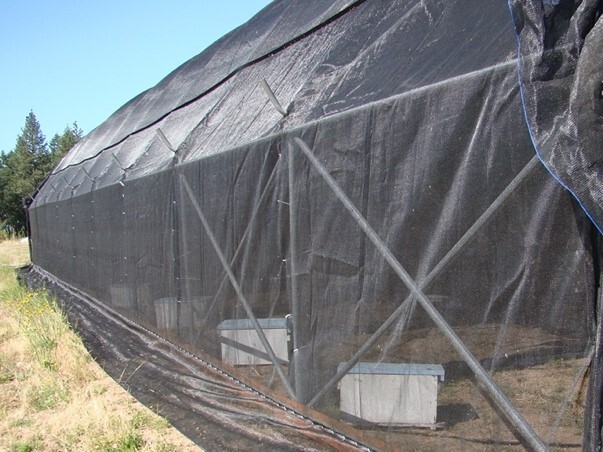
James Ellis, University of Florida
The effects of pesticides on immature honey bee (Apis mellifera) development (2009)
The overall objective of the NAPPC-funded research project was to determine the effects of pesticides on immature honey bees. The project was undertaken at a time when determining such impacts was difficult, given the method available to rear honey bees in vitro (i.e. in the laboratory) had questionable repeatability and low success rates. My team and I were able to make two major accomplishments by undertaking the project. First, we generated important pilot data on pesticide impacts on immature honey bees. Second, we gained valuable insight into and experience with in vitro rearing of honey bee larvae. Both accomplishments were instrumental to our future success with determining the impacts of pesticides on in vitro reared honey bees. In fact, the experience and knowledge we gained from the NAPPC-funded project allowed us to seek additional funding on this topic and publish a number of important manuscripts on honey bee toxicology (see below). For example, we refined the in vitro rearing method, improving it to the point that many laboratories around the world are using it as the preferred method due to its high success rate and repeatability. Furthermore, we have used the method to generate considerable data on pesticide impacts on developing bees (Figure 1). A number of publications resulted from the efforts that followed from the experience we gained conducting the NAPPC-funded project. While NAPPC did not provide funding for the projects cited below, the pilot work accomplished via the NAPPC funding made these projects possible.
Improvement of in vitro rearing method:
1. Schmehl, D.R., Tomé, H.V.V., Mortensen, A.N., Martins, G.F., Ellis, J.D. 2016. Improved protocol for the in vitro rearing of Apis mellifera workers. Journal of Apicultural Research 55(2): 113-129. http://dx.doi.org/10.1080/0021...
Accessing the impacts of pesticides on developing bees:

Jay Evans, North American Pollinator Protection Campaign.
Diagnostic gene panel for honey bee breeding and disease management (2008-2009)
The focus of this grant was to finalize a set of quantitative-PCR markers that would help in the search for markers for disease or stress, and specifically Colony Collapse Disorder (e.g, leading to the Cornman et al 2012 paper below and in figures). The set of conditions developed and tested with NAPPC funds that summer was expanded after this grant to dozens of markers and the scale has continued to increase so that between USDA-ARS projects and the National Honey Bee Disease Survey (run by the Bee Informed Partnership in part in the USDA-ARS Bee Research Lab) 1000’s of samples are analyzed each year for 20+ markers and disease indicators. These projects have employed > 30 high school, undergraduate, and post-graduate students since 2009 and have lasted longer than most disease marker systems.
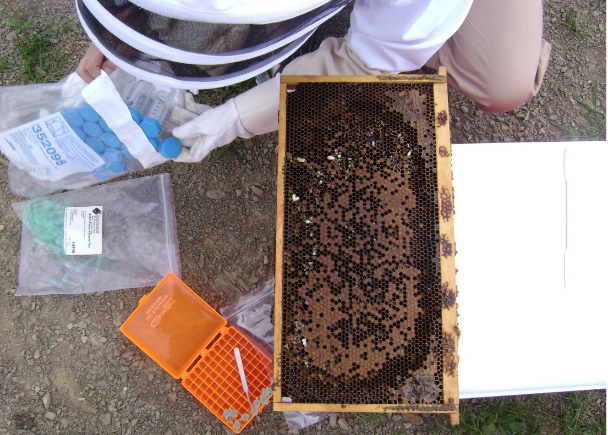
Impacts of nectar compounds on honey bee gut microbes and disease (2012)
This grant helped formalize a collaboration with Drs. Evans, Adler, and Irwin, and associated students to make sense of the impacts of natural nectar compounds on bee health. The results helped show that most such compounds, including amygdalin from almond pollen, have little effect on bee health, while a few potentially decreased pathogens (Palmer-Young et al., 2017). This work has led to extensions with Adler and Irwin leading to focus on specific forage crops (e.g., sunflower) as natural medicinals for bees, and efforts to generalize the search for new bee medicines from natural products. As in the prior project, these research directions have involved numerous students and collaborations between applied bee scientists, geneticists, and ecologists. We hope they will inspire new treatments for bee disease. We recently published a review of protocols and promising candidates for natural products to reduce bee disease.
